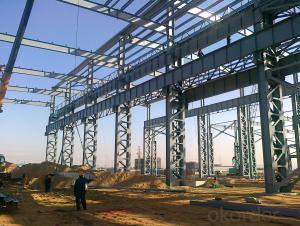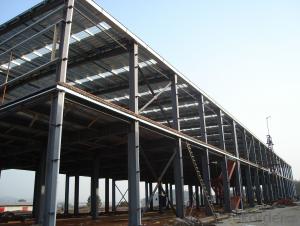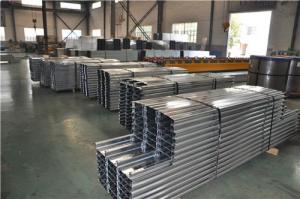Steel structure manufacturer in China
- Loading Port:
- China Main Port
- Payment Terms:
- TT OR LC
- Min Order Qty:
- -
- Supply Capability:
- -
OKorder Service Pledge
OKorder Financial Service
You Might Also Like
Steel Structure Building
1.the connection method of steel structure:
welding connection or bolt connection
2.Steel structure design common norms are as follows:
"Steel Design Code" (GB50017-2003)
"Cold-formed steel structure technical specifications" (GB50018-2002)
"Construction Quality Acceptance of Steel" (GB50205-2001)
"Technical Specification for welded steel structure" (JGJ81-2002, J218-2002)
"Technical Specification for Steel Structures of Tall Buildings" (JGJ99-98)
3.The characteristics of steel
Light weight steel structure
Higher reliability of steel work
Steel anti-vibration (earthquake), impact and good
Steel structure for a higher degree of industrialization
Steel can be assembled quickly and accurately
Large steel interior space
Likely to cause sealing structure
Steel corrosive
Poor fire-resistant steel
Recyclable steel
Steel shorter duration
4.Commonly used steel grades and performance of steel
Carbon structural steel: Q195, Q215, Q235, Q255, Q275, Q345,etc.
High-strength low-alloy structural steel
Quality carbon structural steel and alloy structural steel
Special purpose steel
5.Market:
Products have been all over the country more than 20 provinces, municipalities and autonomous regions, and have been exported to Europe, North America, the Middle East, Africa, Asia and other countries and regions, the widespread use
- Q:How do steel structures provide resistance against foundation settlement?
- Steel structures offer resistance against foundation settlement due to their inherent strength and flexibility. Firstly, steel possesses exceptional durability and high tensile strength, enabling it to withstand heavy loads and forces exerted on the structure. Consequently, the weight of the building can be evenly distributed across the foundation, reducing the risk of settlement. Moreover, steel structures can incorporate deep foundations, such as pile foundations, which effectively transfer the structural load to deeper, more stable soil layers. These pile foundations consist of long, slender columns driven deep into the ground, providing enhanced support and stability. By utilizing pile foundations, the steel structure can effectively counteract settlement caused by weak or compressible soil layers near the surface. Additionally, steel structures possess the advantage of being lightweight when compared to other construction materials. This characteristic reduces the overall load on the foundation, thereby minimizing the potential for settlement. Furthermore, the lightness of steel enables quick and easy construction, resulting in decreased time and cost associated with preventing foundation settlement. Furthermore, steel structures exhibit flexibility under external loads and forces, facilitating the distribution and dissipation of these forces throughout the structure. This flexibility allows the steel structure to accommodate minor movements and settlements without causing significant damage or compromising stability. In conclusion, steel structures provide resistance against foundation settlement through their strength, incorporation of deep foundations, lightweight nature, and flexibility. These characteristics enable the steel structure to effectively distribute loads, transfer weight to stable soil layers, minimize the overall load on the foundation, and adapt to minor movements.
- Q:How much is steel per square meter of steel foundation?
- Generally speaking, the independent base steel content is in 50~60Kg/ cubic concrete.
- Q:What are the different types of steel stadiums?
- There are several different types of steel stadiums, including retractable roof stadiums, open-air stadiums, domed stadiums, and multi-purpose stadiums.
- Q:How are steel structures used in renewable energy projects (solar, wind, etc.)?
- Steel structures are commonly used in renewable energy projects such as solar and wind farms for various purposes. In solar projects, steel is used in the construction of support structures, mounting systems, and frames to hold solar panels in place. These structures provide stability and durability to withstand harsh weather conditions. Similarly, in wind energy projects, steel is used to construct wind turbine towers, which provide support for the turbines and ensure they can capture maximum wind energy. Steel is preferred due to its strength, flexibility, and cost-effectiveness, making it an ideal material for constructing reliable and robust structures in renewable energy projects.
- Q:What are the key considerations in the design of steel structures for industrial applications?
- Several key considerations must be taken into account when designing steel structures for industrial applications. First and foremost, the structural integrity of the steel structure is of utmost importance. Industrial environments typically involve heavy machinery, high loads, and potential impacts, necessitating a structure that can withstand these forces. The design should include thorough load calculations, taking into account not only static loads but also dynamic loads and potential vibrations. Secondly, the durability of the steel structure is a significant factor. Industrial environments can be harsh, with exposure to extreme temperatures, humidity, chemicals, and corrosion. Therefore, the choice of steel grade and protective coatings is critical to ensure the structure remains in optimal condition throughout its intended lifespan. Another crucial consideration is the functionality and layout of the industrial space. The design should account for the specific requirements of the industrial processes, including the arrangement of equipment and machinery, access points, and workflow efficiency. The structure should be flexible enough to accommodate potential future modifications or expansions. Safety is also of utmost importance in the design of steel structures for industrial applications. The design should adhere to all relevant safety standards and regulations, encompassing fire safety, escape routes, and emergency systems. Sufficient provision should be made for the installation of safety features such as handrails, guardrails, and safety barriers. Moreover, cost-effectiveness is an essential consideration. The design should aim to optimize material usage and minimize construction time and costs while still meeting the required performance and safety standards. Lastly, sustainability and environmental impact should be taken into consideration. By incorporating energy-efficient features, utilizing renewable energy sources, and utilizing recyclable materials, the design of steel structures can contribute to reducing the environmental footprint of industrial applications. In conclusion, the successful and efficient design of steel structures for industrial applications requires careful consideration of structural integrity, durability, functionality, safety, cost-effectiveness, and sustainability.
- Q:What are the requirements for designing steel commercial buildings?
- The requirements for designing steel commercial buildings include understanding the project goals, conducting a structural analysis, determining load-bearing capacities, considering building codes and regulations, selecting appropriate materials, ensuring fire and safety codes compliance, and coordinating with other professionals involved in the project such as architects and engineers.
- Q:Can steel structures be designed to be resistant to biological attacks?
- Yes, steel structures can be designed to be resistant to biological attacks. By incorporating appropriate protective coatings and finishes, such as anti-corrosion paints, steel structures can be made less susceptible to biological degradation caused by organisms like bacteria and fungi. Additionally, designing structures with smooth and easily cleanable surfaces helps prevent the accumulation and growth of biological agents. Regular maintenance and inspections are also crucial to identify and address any potential vulnerabilities.
- Q:How do steel structures perform in terms of thermal insulation?
- Steel structures generally have poor thermal insulation properties due to the high thermal conductivity of steel. This means that steel structures tend to transfer heat more easily, resulting in higher energy consumption for heating or cooling. However, thermal insulation can be improved by using additional insulation materials or incorporating insulated panels within the steel structure.
- Q:How are steel structures designed for efficient use of natural resources?
- Steel structures are designed with the efficient use of natural resources in mind through various approaches. Firstly, steel itself is a highly recyclable material. It can be recycled repeatedly without losing its inherent properties, reducing the need for raw materials extraction and conserving natural resources. This feature significantly minimizes the environmental impact of steel production and supports the circular economy. Moreover, steel structures are designed to be lighter and more efficient, requiring less material compared to other construction materials like concrete. This reduced material usage translates into a lower demand for natural resources and reduces the overall environmental footprint. Additionally, the lightweight nature of steel allows for easier transportation, further reducing energy consumption during construction. Steel structures also offer the flexibility to adapt and modify over time, extending their lifespan. This adaptability reduces the need for new construction and associated resource consumption. By allowing easy expansion or reconfiguration, steel structures can accommodate changing needs without requiring a complete overhaul, contributing to sustainable resource management. Furthermore, steel structures are designed to be durable and resistant to environmental factors such as corrosion, fire, and earthquakes. This longevity minimizes the need for frequent maintenance, repairs, and replacements, thus reducing the consumption of materials and energy throughout the life cycle of the structure. Lastly, the design of steel structures takes into consideration energy efficiency. The use of efficient insulation systems, energy-saving lighting, and optimized HVAC systems reduces the energy consumption of these buildings. By reducing energy demand, steel structures help conserve natural resources used for energy production. In conclusion, steel structures are designed for efficient use of natural resources through the recyclability of steel, lightweight design, adaptability, durability, and energy efficiency. These considerations not only minimize the environmental impact but also contribute to sustainable resource management and a greener future.
- Q:Is cast-in-place concrete attic good or steel structure + ALC board good?!
- The short cycle of cast-in-place steel structure high stability, light weight, does not destroy the original structure, anchorage hole cast-in-place the original wall hit double row hole spacing of ten cm each with adhesive implantation wall, wall depth of ten to fifteen cm, and the steel structure is not greater than the chemical anchor spacing bolt with wall of not less than thirty cm fifty cm fifteen cm deep into the root.
1. Manufacturer Overview |
|
|---|---|
| Location | |
| Year Established | |
| Annual Output Value | |
| Main Markets | |
| Company Certifications | |
2. Manufacturer Certificates |
|
|---|---|
| a) Certification Name | |
| Range | |
| Reference | |
| Validity Period | |
3. Manufacturer Capability |
|
|---|---|
| a)Trade Capacity | |
| Nearest Port | |
| Export Percentage | |
| No.of Employees in Trade Department | |
| Language Spoken: | |
| b)Factory Information | |
| Factory Size: | |
| No. of Production Lines | |
| Contract Manufacturing | |
| Product Price Range | |
Send your message to us
Steel structure manufacturer in China
- Loading Port:
- China Main Port
- Payment Terms:
- TT OR LC
- Min Order Qty:
- -
- Supply Capability:
- -
OKorder Service Pledge
OKorder Financial Service
Similar products
New products
Hot products
Hot Searches
Related keywords





























